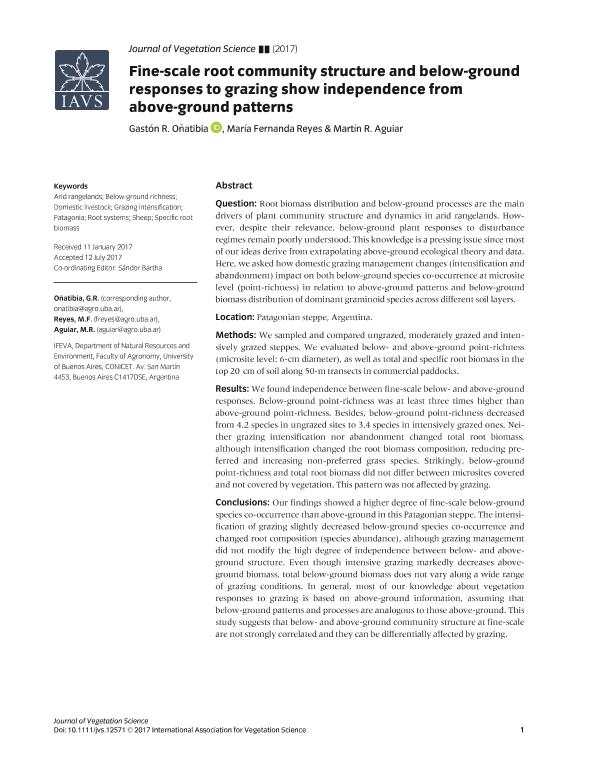Artículo
Fine-scale root community structure and below-ground responses to grazing show independence from above-ground patterns
Fecha de publicación:
11/2017
Editorial:
Wiley Blackwell Publishing, Inc
Revista:
Journal of Vegetation Science
ISSN:
1100-9233
Idioma:
Inglés
Tipo de recurso:
Artículo publicado
Clasificación temática:
Resumen
Question: Root biomass distribution and below-ground processes are the main drivers of plant community structure and dynamics in arid rangelands. However, despite their relevance, below-ground plant responses to disturbance regimes remain poorly understood. This knowledge is a pressing issue since most of our ideas derive from extrapolating above-ground ecological theory and data. Here, we asked how domestic grazing management changes (intensification and abandonment) impact on both below-ground species co-occurrence at microsite level (point-richness) in relation to above-ground patterns and below-ground biomass distribution of dominant graminoid species across different soil layers. Location: Patagonian steppe, Argentina. Methods: We sampled and compared ungrazed, moderately grazed and intensively grazed steppes. We evaluated below- and above-ground point-richness (microsite level: 6-cm diameter), as well as total and specific root biomass in the top 20 cm of soil along 50-m transects in commercial paddocks. Results: We found independence between fine-scale below- and above-ground responses. Below-ground point-richness was at least three times higher than above-ground point-richness. Besides, below-ground point-richness decreased from 4.2 species in ungrazed sites to 3.4 species in intensively grazed ones. Neither grazing intensification nor abandonment changed total root biomass, although intensification changed the root biomass composition, reducing preferred and increasing non-preferred grass species. Strikingly, below-ground point-richness and total root biomass did not differ between microsites covered and not covered by vegetation. This pattern was not affected by grazing. Conclusions: Our findings showed a higher degree of fine-scale below-ground species co-occurrence than above-ground in this Patagonian steppe. The intensification of grazing slightly decreased below-ground species co-occurrence and changed root composition (species abundance), although grazing management did not modify the high degree of independence between below- and above-ground structure. Even though intensive grazing markedly decreases above-ground biomass, total below-ground biomass does not vary along a wide range of grazing conditions. In general, most of our knowledge about vegetation responses to grazing is based on above-ground information, assuming that below-ground patterns and processes are analogous to those above-ground. This study suggests that below- and above-ground community structure at fine-scale are not strongly correlated and they can be differentially affected by grazing.
Archivos asociados
Licencia
Identificadores
Colecciones
Articulos(IFEVA)
Articulos de INST.D/INV.FISIOLOGICAS Y ECO.VINCULADAS A L/AGRIC
Articulos de INST.D/INV.FISIOLOGICAS Y ECO.VINCULADAS A L/AGRIC
Citación
Oñatibia, Gastón Rafael; Reyes, María Fernanda; Aguiar, Martin Roberto; Fine-scale root community structure and below-ground responses to grazing show independence from above-ground patterns; Wiley Blackwell Publishing, Inc; Journal of Vegetation Science; 28; 6; 11-2017; 1097-1106
Compartir
Altmétricas




